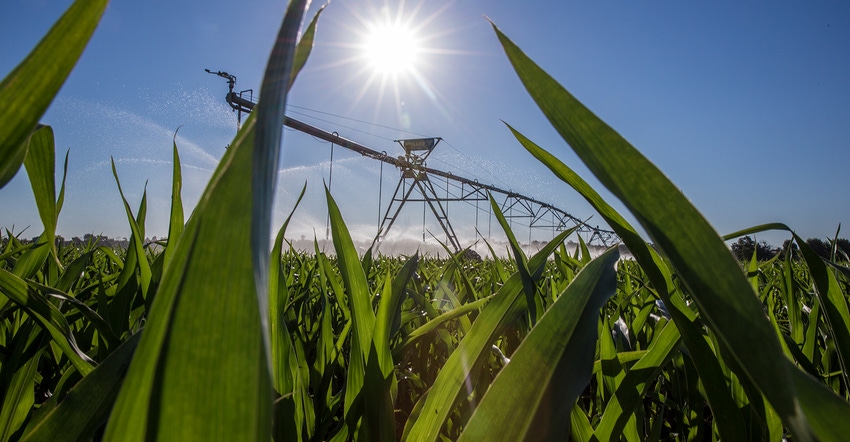November 6, 2019

Aerial imagery never really left the ag scene, but for some time it was pushed aside as other precision ag tools came forward. That’s changing as more farmers get access to regular eye-in-the-sky looks at their operations. But the challenge is deciphering what those images are telling you, and what actions you should take.
Valley Irrigation is finding out that answer through a partnership initiated earlier in 2019 with startup Prospera Technologies. The program, called Valley Insights, is taking aerial imagery and applying machine learning to provide a better decision tool for users.
“We were flying those fields every week and delivering insights to farmers,” says Craig Bell, product manager, Valley. “The growers could take action based on the notifications.”
Instead of simply sharing aerial pictures of fields, the system would process the images and analyze the crop for deficiencies, or abundances, of water. The aim was not only to tighten up water use, but also avoid the dreaded yield-robbing underapplication of water.
Darren Siekman, vice president, water delivery and business development, Valley, explains that while he doesn’t want to denigrate in-field sensors, there was more information from the imagery. “We’re using processing power and imagery to look at the whole field versus information from a finite-discrete sensor in one part of the field,” he says. “We’re not limited to that spot in the field.”
The whole-field view, combined with imagery across a whole farm, allowed farmers to make better decisions for how to deploy resources. Instead of traveling to view how each field was performing, they could rely on alerts from the system to target the pivots that appeared to need attention.
Targeting action
More farmers are getting aerial imagery, but a pile of images is worth little if those images don’t save time. That’s where the Prospera tech comes in. Bell explains that processing the images allows the company to send notifications or alerts to farmers when there is a real issue. This was the pilot year for test farmers, and the company worked in two states — Washington and Nebraska.
The key to the system is when something goes wrong; but in 2019, Nebraska was pretty wet. “Obviously, the way the season was, there were fewer anomalies being sent to [Nebraska growers],” Bell says. “They didn’t turn on their pivots. We had a more normal year in Washington.”
The key is catching trouble before it costs too much. That’s the idea for the machine learning tool driving Valley Insights. The idea is that the system identifies trouble — say, an underperforming sprinkler. The grower can take action right then to slow the pivot, or speed it up to match crop needs.
Siekman recalls that one Washington test grower initially ignored the notifications from the system he received on his cellphone — for four weeks. “Then he says that’s when he found he had a real problem with a pivot in that field,” Siekman recalls. “The farmer is getting new insights that may or not be a problem; but if he had checked it right away, and not waited four weeks, he would have gotten ahead of the problem.”
And that’s a key to this system, too: It’s predictive. Knowing weather for the area and understanding the weather conditions, the Prospera system can divine potential impact before it happens. That’s when a notification goes out, so you can avoid trouble more easily.
Test program
For 2019, farmers were in a test program. When anomaly notices were sent, not only did the farmer get the information, but also, his dealer did. That feedback loop allowed Valley to get a handle on the system’s performance. The farmer-dealer relationships that Valley has have helped identify test farmers.
Bell shares that in Nebraska, they had historical information they could share showing how artificial intelligence could identify trouble. They used historical maps from 2018 to demonstrate how the system would have spotted trouble sooner than with the naked eye. That helped recruit farmers into the program.
Henry Boersma, a Moses Lake, Wash., farmer, took part in the trial and says his crops are already benefiting from the technology. “When Valley Insights identifies underwatering in certain sectors and alerts us that sprinklers appear to be plugged on certain spans, that’s exactly what’s happening,” he says. “We have another eye in the field, so we can identify issues and make corrections long before we could see stress on our crops with the naked eye.”
This was the test year, and farmers like Boersma participated in the program but paid no fees. Siekman says the company is already getting interest from farmers who want to subscribe to the service for 2020. “We’re looking at how we expand this service next year. We’re going to be in Washington and Nebraska, with more acres,” he says. “But we have limited-release geography, and there will be enhancements to the system.”
Prospera and Valley are also developing an on-pivot sensor that could be more precise, work anywhere and offer more frequent real-time information for the future. Add in that the launch of Valley 365 will bring the Valley Insights information into a centralized platform, and growers will see some significant advancement in 2020.
You can learn more by visiting valleyirrigation.com.
About the Author(s)
You May Also Like






